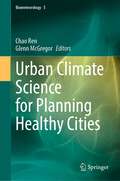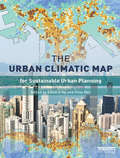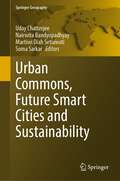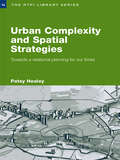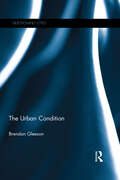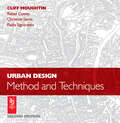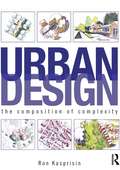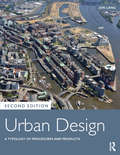- Table View
- List View
Urban Climate Mitigation Techniques
by Mat Santamouris Denia KolokotsaThe urban climate is continuously deteriorating. Urban heat lowers the quality of urban life, increases energy needs, and affects the urban socio-economy. Urban Climate Mitigation Techniques presents steps that can be taken to mitigate this situation through a series of innovative technologies and examples of best practices for the improvement of the urban climate. Including tools for evaluation and a comparative analysis, this book addresses anthropogenic heat, green areas, cool materials and pavements, outdoor shading structures, evaporative cooling and earth cooling. Case studies demonstrate the success and applicability of these measures in various cities throughout the world. Useful for urban designers, architects and planners, Urban Climate Mitigation Techniques is a step by step tour of the innovative technologies improving our urban climate, providing a holistic approach supported by well-established quantitative examples.
Urban Climate Mitigation Techniques
by Mat Santamouris Denia KolokotsaThe urban climate is continuously deteriorating. Urban heat lowers the quality of urban life, increases energy needs, and affects the urban socio-economy. Urban Climate Mitigation Techniques presents steps that can be taken to mitigate this situation through a series of innovative technologies and examples of best practices for the improvement of the urban climate. Including tools for evaluation and a comparative analysis, this book addresses anthropogenic heat, green areas, cool materials and pavements, outdoor shading structures, evaporative cooling and earth cooling. Case studies demonstrate the success and applicability of these measures in various cities throughout the world. Useful for urban designers, architects and planners, Urban Climate Mitigation Techniques is a step by step tour of the innovative technologies improving our urban climate, providing a holistic approach supported by well-established quantitative examples.
Urban Climate Science for Planning Healthy Cities (Biometeorology #5)
by Chao Ren Glenn McGregorThis volume demonstrates how urban climate science can provide valuable information for planning healthy cities. The book illustrates the idea of "Science in Time, Science in Place" by providing worldwide case-based urban climatic planning applications for a variety of regions and countries, utilizing relevant climatic-spatial planning experiences to address local climatic and environmental health issues. Comprised of three major sections entitled "The Rise of Mega-cities and the Concept of Climate Resilience and Healthy Living," "Urban Climate Science in Action," and "Future Challenges and the Way Forward," the book argues for the recognition of climate as a key element of healthy cities. Topics covered include: urban resilience in a climate context, climate responsive planning and urban climate interventions to achieve healthy cities, climate extremes, public health impact, urban climate-related health risk information, urban design and planning, and governance and management of sustainable urban development. The book will appeal to an international audience of practicing planners and designers, public health and built environment professionals, social scientists, researchers in epidemiology, climatology and biometeorology, and international to city scale policy makers.
The Urban Climatic Map: A Methodology for Sustainable Urban Planning
by Edward Ng Chao RenRapid urbanization, higher density and more compact cities have brought about a new science of urban climatology. An understanding of the mapping of this phenomenon is crucial for urban planners. The book brings together experts in the field of Urban Climatic Mapping to provide the state of the art understanding on how urban climatic knowledge can be made available and utilized by urban planners. The book contains the technology, methodology, and various focuses and approaches of urban climatic map making. It illustrates this understanding with examples and case studies from around the world, and it explains how urban climatic information can be analysed, interpreted and applied in urban planning. The book attempts to bridge the gap between the science of urban climatology and the practice of urban planning. It provides a useful one-stop reference for postgraduates, academics and urban climatologists wishing to better understand the needs for urban climatic knowledge in city planning; and urban planners and policy makers interested in applying the knowledge to design future sustainable cities and quality urban spaces.
The Urban Climatic Map: A Methodology for Sustainable Urban Planning
by Edward Ng Chao RenRapid urbanization, higher density and more compact cities have brought about a new science of urban climatology. An understanding of the mapping of this phenomenon is crucial for urban planners. The book brings together experts in the field of Urban Climatic Mapping to provide the state of the art understanding on how urban climatic knowledge can be made available and utilized by urban planners. The book contains the technology, methodology, and various focuses and approaches of urban climatic map making. It illustrates this understanding with examples and case studies from around the world, and it explains how urban climatic information can be analysed, interpreted and applied in urban planning. The book attempts to bridge the gap between the science of urban climatology and the practice of urban planning. It provides a useful one-stop reference for postgraduates, academics and urban climatologists wishing to better understand the needs for urban climatic knowledge in city planning; and urban planners and policy makers interested in applying the knowledge to design future sustainable cities and quality urban spaces.
Urban Coding and Planning (Planning, History and Environment Series)
by Stephen MarshallUrban codes have a profound influence on urban form, affecting the design and placement of buildings, streets and public spaces. Historically, their use has helped create some of our best-loved urban environments, while recent advances in coding have been a growing focus of attention, particularly in Britain and North America. However, the full potential for the role of codes has yet to be realized. In Urban Coding and Planning, Stephen Marshall and his contributors investigate the nature and scope of coding; its purposes; the kinds of environments it creates; and, perhaps most importantly, its relationship to urban planning. By bringing together historical and ongoing traditions of coding from around the world – with chapters describing examples from the United Kingdom, France, India, China, Japan, Australia, South Africa, the United States and Latin America – this book provides lessons for today’s theory and practice of place-making.
Urban Coding and Planning (Planning, History and Environment Series)
by Stephen MarshallUrban codes have a profound influence on urban form, affecting the design and placement of buildings, streets and public spaces. Historically, their use has helped create some of our best-loved urban environments, while recent advances in coding have been a growing focus of attention, particularly in Britain and North America. However, the full potential for the role of codes has yet to be realized. In Urban Coding and Planning, Stephen Marshall and his contributors investigate the nature and scope of coding; its purposes; the kinds of environments it creates; and, perhaps most importantly, its relationship to urban planning. By bringing together historical and ongoing traditions of coding from around the world – with chapters describing examples from the United Kingdom, France, India, China, Japan, Australia, South Africa, the United States and Latin America – this book provides lessons for today’s theory and practice of place-making.
Urban Commons, Future Smart Cities and Sustainability (Springer Geography)
by Uday Chatterjee Nairwita Bandyopadhyay Martiwi Diah Setiawati Soma SarkarThis book provides a critical theoretical framework for understanding the implementation and development of smart cities as innovation drivers, with long-term effects on productivity, livability, and the sustainability of specific initiatives. This framework is based on an empirical analysis of 21 case studies, which include pioneer projects from various regions. It investigates how successful smart city initiatives foster technological innovation by combining regulatory governance and private agency. The typologies of smart city-making approaches are thoroughly examined. This book presents the holistic approach of smart cities, which start from current issue and challenges, advanced technological development, disaster mitigation, ecological perspective, social issue, and urban governance. The book is organized into five major parts, which reflect interconnection between theories and practice. Part one explains the introduction which reflects the diversity and challenges of the urban commons and its regeneration. Part two covers the current and future situation of urban growth, anglomeration agglomeration, and urban infrastructure. This section includes rethinking urban sprawl: moving towards sustainable cities, drivers of urban growth and infrastructure, urban land use dynamics and urban sprawl and urban infrastructure sustainability and resilience. Part three describes climate crisis, urban health, and waste management. This section includes climate change and health impacts in urban areas, green spaces: an invaluable resource for delivering sustainable urban health, health and wellbeing and quality of life in the changing urban environment, urban climate and pollution—case study, sustainable urban waste management and urban sustainability and global warming and urban heat Island. Part four covers the ecological perspectives, advanced technology, and social impact for i.e., smart building, ecosystem services, society and future smart cities (SSC). This section includes urban ecosystem services, environmental planning, and city management, artificial intelligence and urban hazards and societal impact, and using geospatial application and urban/smart city energy conservation—case study. Part five covers urban governance, smart solutions, and sustainable cities. It includes good governance, especially e-governance and citizen participation, urban governance, space and policy planning to achieve sustainability, smart city planning and management and Internet of things (IoT), advances in smart roads for future smart cities, sustainable city planning, innovation, and management, future strategy for sustainable smart cities and lessons from the pandemic: the future of smart cities.
Urban Complexity and Planning: Theories and Computer Simulations
by Shih-Kung Lai Haoying HanIn recent years, there has been a new understanding of how cities evolve and function, which reflects the emergent paradigm of complexity. The crux of this view is that cities are created by differentiated actors involved in individual, small-scale projects interacting in a complex way in the urban development process. This 'bottom up' approach to urban modeling not only transforms our understanding of cities, but also improves our capabilities of harnessing the urban development process. For example, we used to think that plans control urban development in an aggregate, holistic way, but what actually happens is that plans only affect differentiated actors in seeking their goals through information. In other words, plans and regulations set restrictions or incentives of individual behaviour in the urban development process through imposing rights, information, and prices, and the analysis of the effects of plans and regulations must take into account the complex urban dynamics at a disaggregate level of the urban development process. Computer simulations provide a rigorous, promising analytic tool that serves as a supplement to the traditional, mathematical approach to depicting complex urban dynamics. Based on the emergent paradigm of complexity, the book provides an innovative set of arguments about how we can gain a better understanding of how cities emerge and function through computer simulations, and how plans affect the evolution of complex urban systems in a way distinct from what we used to think they should. Empirical case studies focus on the development of a compact urban hierarchy in Taiwan, China, and the USA, but derive more generalizable principles and relationships among cities, complexity, and planning.
Urban Complexity and Planning: Theories and Computer Simulations
by Shih-Kung Lai Haoying HanIn recent years, there has been a new understanding of how cities evolve and function, which reflects the emergent paradigm of complexity. The crux of this view is that cities are created by differentiated actors involved in individual, small-scale projects interacting in a complex way in the urban development process. This 'bottom up' approach to urban modeling not only transforms our understanding of cities, but also improves our capabilities of harnessing the urban development process. For example, we used to think that plans control urban development in an aggregate, holistic way, but what actually happens is that plans only affect differentiated actors in seeking their goals through information. In other words, plans and regulations set restrictions or incentives of individual behaviour in the urban development process through imposing rights, information, and prices, and the analysis of the effects of plans and regulations must take into account the complex urban dynamics at a disaggregate level of the urban development process. Computer simulations provide a rigorous, promising analytic tool that serves as a supplement to the traditional, mathematical approach to depicting complex urban dynamics. Based on the emergent paradigm of complexity, the book provides an innovative set of arguments about how we can gain a better understanding of how cities emerge and function through computer simulations, and how plans affect the evolution of complex urban systems in a way distinct from what we used to think they should. Empirical case studies focus on the development of a compact urban hierarchy in Taiwan, China, and the USA, but derive more generalizable principles and relationships among cities, complexity, and planning.
Urban Complexity and Spatial Strategies: Towards a Relational Planning for Our Times (RTPI Library Series)
by Patsy HealeyUrban Complexity and Spatial Strategies develops important new relational and institutionalist approaches to policy analysis and planning, of relevance to all those with an interest in cities and urban areas. Well-illustrated chapters weave together conceptual development, experience and implications for future practice and address the challenge of urban and metropolitan planning and development. Useful for students, social scientists and policy makers, Urban Complexity and Spatial Strategies offers concepts and detailed cases of interest to those involved in policy development and management, as well as providing a foundation of ideas and experiences, an account of the place-focused practices of governance and an approach to the analysis of governance dynamics. For those in the planning field itself, this book re-interprets the role of planning frameworks in linking spatial patterns to social dynamics with twenty-first century relevance.
Urban Complexity and Spatial Strategies: Towards a Relational Planning for Our Times (RTPI Library Series)
by Patsy HealeyUrban Complexity and Spatial Strategies develops important new relational and institutionalist approaches to policy analysis and planning, of relevance to all those with an interest in cities and urban areas. Well-illustrated chapters weave together conceptual development, experience and implications for future practice and address the challenge of urban and metropolitan planning and development. Useful for students, social scientists and policy makers, Urban Complexity and Spatial Strategies offers concepts and detailed cases of interest to those involved in policy development and management, as well as providing a foundation of ideas and experiences, an account of the place-focused practices of governance and an approach to the analysis of governance dynamics. For those in the planning field itself, this book re-interprets the role of planning frameworks in linking spatial patterns to social dynamics with twenty-first century relevance.
The Urban Condition (Questioning Cities)
by Brendan GleesonThis book will speak to the new human epoch, the Urban Age. A majority of humanity now lives for the first time in cities. The city, the highest invention of the modern age, is now the human heartland. And yet the same process that brought us the city and its wonders, modernisation, has also thrown up challenges and threats, especially climate change, resource depletion, social division and economic insecurity. This book considers how these threats are encountered and countered in the urban age, focusing on the issue of human knowledge and self-awareness, just as Hannah Arendt’s influential The Human Condition did half a century ago. The Human Condition is now The Urban Condition. And it is this condition that will define human prospects in an age of default and risk. Gleeson expertly explores the concept through three main themes. The first is an exploration of what defines the current human condition, especially the expanding cities that are at the heart of an over-consumptive world economic order. The second exposes and reviews the reawakening of forms of knowledge (‘naturalism’) that are likely to worsen not improve our comprehension of the crisis. The new ‘science of urbanism’ in popular new literature exemplifies this dangerous trend. The third and last part of the book considers prospects for a new urban, and therefore human, dispensation, ‘The Good City’. We must first journey in our urban vessels through troubled times. But can we now start to plot the way to new shores, to a safer, more resilient city that provides for human flourishing? The Urban Condition attempts this ideal, conceiving a new urbanism based on the old idea of self-limitation. The Urban Condition is an original, timely book that reconsiders and redeploys Arendt’s famous notion of The Human Condition in an age of cities and risk. It brings together several important strands of human consideration, urbanisation, climate threat, resource depletion, economic default and critical knowledge and weaves them into a new analysis of the times. It also looks to a future that is nearly with us—of changed climate, resource scarcity and economic stress. The book journeys into these troubled times, proposing the idea of Lifeboat Cities as a way of thinking about the human journey to come
The Urban Condition (Questioning Cities)
by Brendan GleesonThis book will speak to the new human epoch, the Urban Age. A majority of humanity now lives for the first time in cities. The city, the highest invention of the modern age, is now the human heartland. And yet the same process that brought us the city and its wonders, modernisation, has also thrown up challenges and threats, especially climate change, resource depletion, social division and economic insecurity. This book considers how these threats are encountered and countered in the urban age, focusing on the issue of human knowledge and self-awareness, just as Hannah Arendt’s influential The Human Condition did half a century ago. The Human Condition is now The Urban Condition. And it is this condition that will define human prospects in an age of default and risk. Gleeson expertly explores the concept through three main themes. The first is an exploration of what defines the current human condition, especially the expanding cities that are at the heart of an over-consumptive world economic order. The second exposes and reviews the reawakening of forms of knowledge (‘naturalism’) that are likely to worsen not improve our comprehension of the crisis. The new ‘science of urbanism’ in popular new literature exemplifies this dangerous trend. The third and last part of the book considers prospects for a new urban, and therefore human, dispensation, ‘The Good City’. We must first journey in our urban vessels through troubled times. But can we now start to plot the way to new shores, to a safer, more resilient city that provides for human flourishing? The Urban Condition attempts this ideal, conceiving a new urbanism based on the old idea of self-limitation. The Urban Condition is an original, timely book that reconsiders and redeploys Arendt’s famous notion of The Human Condition in an age of cities and risk. It brings together several important strands of human consideration, urbanisation, climate threat, resource depletion, economic default and critical knowledge and weaves them into a new analysis of the times. It also looks to a future that is nearly with us—of changed climate, resource scarcity and economic stress. The book journeys into these troubled times, proposing the idea of Lifeboat Cities as a way of thinking about the human journey to come
Urban Connections in the Contemporary Pedestrian Landscape
by Philip PregillUrban Connections in the Contemporary Pedestrian Landscape explores the significant physical and cultural changes in our urban areas following the implementation of design strategies and increased pedestrian activity. Beginning with a history of the urban grid, the book then discusses experiential factors of pedestrianized urban landscapes in three scales, arterials, collectors and locals, with an emphasis on inductive and deductive design alternatives. It closely examines elements derived from current urban pedestrian experiences including form, scale, surfaces and identity and provides alternative design solutions for the future. Uniquely focusing on a hierarchical discussion of the quality of contemporary landscape design applications within the urban grid, and with illustrated examples throughout the text, this will be useful recommended reading for academics, researchers and postgraduate students on urban landscape and design courses.
Urban Connections in the Contemporary Pedestrian Landscape
by Philip PregillUrban Connections in the Contemporary Pedestrian Landscape explores the significant physical and cultural changes in our urban areas following the implementation of design strategies and increased pedestrian activity. Beginning with a history of the urban grid, the book then discusses experiential factors of pedestrianized urban landscapes in three scales, arterials, collectors and locals, with an emphasis on inductive and deductive design alternatives. It closely examines elements derived from current urban pedestrian experiences including form, scale, surfaces and identity and provides alternative design solutions for the future. Uniquely focusing on a hierarchical discussion of the quality of contemporary landscape design applications within the urban grid, and with illustrated examples throughout the text, this will be useful recommended reading for academics, researchers and postgraduate students on urban landscape and design courses.
The Urban Contract: Community, Governance and Capitalism
by Paolo PerulliToday, the increasing mobility of capital, people and information has changed the space relations of urban societies. Contractual relations have increased in every field of social life: in the economic field, but also in the political, and in creative and scientific areas. Contracts are not only legal frameworks or economic aggregates of individuals, but socially embedded forms. The concept of urban contract proposed in this book combines the theoretical body of economic-juridical literature on the contract with that of historical-anthropological and socio-spatial literature on the city. Through a diverse range of ten city case studies, The Urban Contract compares European, North-American and Asian Urban Contracts. It concludes with a theoretical proposal for understanding the deep dialectical nature of Contract Cities: their reciprocity and competition, their dual trend towards growth and decay, their cyclical nature as agents of change and disruption of the social forms of urbanity.
The Urban Contract: Community, Governance and Capitalism
by Paolo PerulliToday, the increasing mobility of capital, people and information has changed the space relations of urban societies. Contractual relations have increased in every field of social life: in the economic field, but also in the political, and in creative and scientific areas. Contracts are not only legal frameworks or economic aggregates of individuals, but socially embedded forms. The concept of urban contract proposed in this book combines the theoretical body of economic-juridical literature on the contract with that of historical-anthropological and socio-spatial literature on the city. Through a diverse range of ten city case studies, The Urban Contract compares European, North-American and Asian Urban Contracts. It concludes with a theoretical proposal for understanding the deep dialectical nature of Contract Cities: their reciprocity and competition, their dual trend towards growth and decay, their cyclical nature as agents of change and disruption of the social forms of urbanity.
Urban Crime Control in Cinema: Fallen Guardians and the Ideology of Repression (Palgrave Studies in Crime, Media and Culture)
by Vladimir RizovThis book uses popular films to understand the convergence of crime control and the ideology of repression in contemporary capitalism. It focuses on the cinematic figure of the fallen guardian, a protagonist who, in the course of a narrative, falls from grace and becomes an enemy of the established social order. The fallen guardian is a figure that allows for the analysis of a particular crime control measure through the perspective of both an enforcer and a target. The very notion of ‘justice’ is challenged, and questions are posed in relation to the role that films assume in the reproduction of policing as it is. In doing so, the book combines a historical far-reaching perspective with popular culture analysis. At the core remains the value of the cinematic figure of the fallen guardian for contemporary understandings of urban space and urban crime control and how films are clear examples of the ways in which the ideology of repression is reproduced.This book questions the justifications that are often given for social control in cities and understands cinema as a medium for offering critique of such processes and justifications. Explored are the crime control measures of private policing in relation to RoboCop (1987), preventative policing and Minority Report (2002), mass incarceration in The Dark Knight Rises (2012), and extra-judicial killing in Blade Runner 2049 (2017). The book speaks to those interested in crime control in critical criminology, cultural criminology, urban studies, and beyond.
Urban Design: Method And Techniques
by Rafael Cuesta Christine Sarris Paola Signoretta J.C MoughtinThis book deals with a wide range of techniques used in the urban design process. It then goes on to relate these techniques to a unique, comprehensive account of method. A method of urban design is developed which has sustainability and environmental protection at the centre of its philosophy. Previously, literature regarding the urban design method has been almost totally neglected; this book introduces the topic to the reader. This revised Second Edition encompasses the latest techniques including the development of geographic information systems and financial techniques which help evaluate projects.A number of techniques are illustrated by example or case study. Where techniques are discussed they are located within the structure of the design process. The book develops a logical framework for a process, which includes problem definition, survey, analysis, concept generation, evaluation and implementation. It is this framework which leads toward the development of an urban design method. This book is a practical guide for students or professionals in the early part of their careers. It is organized so that each chapter provides guidance which readers would have otherwise had to discover for themselves, often with some difficulty.
Urban Design: The Composition of Complexity
by Ron KasprisinFor planning to be successful, design must mean more than simply blindly following the dictates of legislation and regulation – yet losing sight of the importance of the design process is all too often exactly what has happened. Ron Kasprisin has written a book for students of planning and urban design that reconnects the process of designing with outcomes on the ground, and puts thinking about design back at the heart of what planners do. The book identifies the elements and principles of composition and explores compositional order and structure as they relate to the meaning and functionality of cities. It discusses new directions and methods, outlines the importance of both buildings and the open spaces between them. Mixing accessible theory, practical examples and carefully designed exercises in composition from simple to complex settings, Urban Design is an essential textbook for classrooms and design studios across the full spectrum of planning and urban studies fields. Not only filled with illustrations and graphics of excellent projects, it gives students tools to enable them to sketch, draw, design and above all, to think.
Urban Design: The Composition of Complexity
by Ron KasprisinFor planning to be successful, design must mean more than simply blindly following the dictates of legislation and regulation – yet losing sight of the importance of the design process is all too often exactly what has happened. Ron Kasprisin has written a book for students of planning and urban design that reconnects the process of designing with outcomes on the ground, and puts thinking about design back at the heart of what planners do. The book identifies the elements and principles of composition and explores compositional order and structure as they relate to the meaning and functionality of cities. It discusses new directions and methods, outlines the importance of both buildings and the open spaces between them. Mixing accessible theory, practical examples and carefully designed exercises in composition from simple to complex settings, Urban Design is an essential textbook for classrooms and design studios across the full spectrum of planning and urban studies fields. Not only filled with illustrations and graphics of excellent projects, it gives students tools to enable them to sketch, draw, design and above all, to think.
Urban Design: The Composition of Complexity
by Ron KasprisinUrban design is a process of establishing a structural order within human settlements; responding to dynamic emergent meanings and functions in a constant state of flux. The planning/design process is complex due to the myriad of on-going (urban) organizational and structural relationships and contexts. This book reconnects the process with outcomes on the ground, and puts thinking about design back at the heart of what planners do. Mixing accessible theory, practical examples, and carefully designed exercises in composition from simple to complex settings, Urban Design is an essential textbook for classrooms and design studios across the full spectrum of planning and urban studies fields. Filled with color illustrations and graphics of excellent projects, it gives students tools to enable them to sketch, draw, design, and above all, to think. This new edition remains focused on instructing the student, professional and layperson in the elements and principles of design composition so that they can diverge from conventional and packaged solutions in pursuit of a meaningful and creative urbanism. This edition builds upon established design principles and encourages the student in creative ways to depart from them as appropriate in dealing with the complexity of culture, space and time dynamics of cities. The book identifies the elements and principles of compositions and explores compositional order and structure as they relate to the meaning and functionality of cities. It discusses new directions and methods, and outlines the importance of both buildings and the open spaces between them.
Urban Design: The Composition of Complexity
by Ron KasprisinUrban design is a process of establishing a structural order within human settlements; responding to dynamic emergent meanings and functions in a constant state of flux. The planning/design process is complex due to the myriad of on-going (urban) organizational and structural relationships and contexts. This book reconnects the process with outcomes on the ground, and puts thinking about design back at the heart of what planners do. Mixing accessible theory, practical examples, and carefully designed exercises in composition from simple to complex settings, Urban Design is an essential textbook for classrooms and design studios across the full spectrum of planning and urban studies fields. Filled with color illustrations and graphics of excellent projects, it gives students tools to enable them to sketch, draw, design, and above all, to think. This new edition remains focused on instructing the student, professional and layperson in the elements and principles of design composition so that they can diverge from conventional and packaged solutions in pursuit of a meaningful and creative urbanism. This edition builds upon established design principles and encourages the student in creative ways to depart from them as appropriate in dealing with the complexity of culture, space and time dynamics of cities. The book identifies the elements and principles of compositions and explores compositional order and structure as they relate to the meaning and functionality of cities. It discusses new directions and methods, and outlines the importance of both buildings and the open spaces between them.
Urban Design: A Typology of Procedures and Products
by Jon LangUrban Design: A Typology of Procedures and Products, 2nd Edition provides a comprehensive and accessible introduction to urban design, defining the field and addressing the controversies and goals of urban design. Including over 50 updated international case studies, this new edition presents a three-dimensional model with which to categorize the processes and products involved: product type, paradigm type, and procedural type. The case studies not only illuminate the typology but provide information that designers can use as precedents in their own work. Uniquely, these case study projects are framed by the design paradigm employed, categorized by procedural type instead of instrumental or land use function. The categories used here are Total Urban Design, All-of-a-piece Urban Design, Plug-in Urban Design, and Piece-by-piece Urban Design.Written for both professionals and those encountering urban design in their day-to-day life, Urban Design is an essential introduction to the field and practice, considering the future direction of the field and what can be learned from the past.

